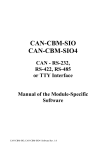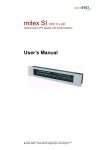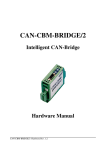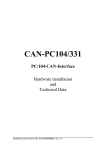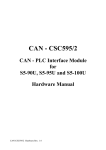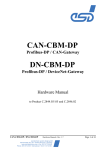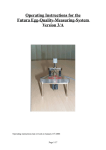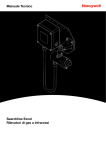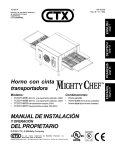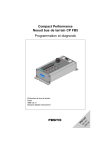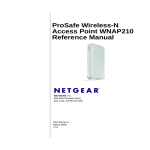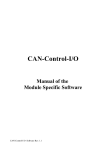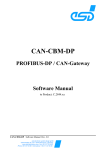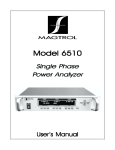Download CAN-CBM-SIO1 CAN-CBM-SIO4 CAN-CBM-PLC/331-1
Transcript
CAN-CBM-SIO1 CAN-CBM-SIO4 CAN - RS-232, RS-422, RS-485 or TTY-Interface CAN-CBM-PLC/331-1 Automation Computer with CAN-Interface Hardware Manual CAN-CBM-SIO1 / CAN-CBM-SIO4 / CAN-CBM-PLC/331-1 Hardware Rev. 2.0 NOTE The information in this document has been carefully checked and is believed to be entirely reliable. esd makes no warranty of any kind with regard to the material in this document, and assumes no responsibility for any errors that may appear in this document. esd reserves the right to make changes without notice to this, or any of its products, to improve reliability, performance or design. esd assumes no responsibility for the use of any circuitry other than circuitry which is part of a product of esd gmbh. esd does not convey to the purchaser of the product described herein any license under the patent rights of esd gmbh nor the rights of others. esd electronic system design gmbh Vahrenwalder Str. 205 30165 Hannover Germany Phone: Fax: E-mail: Internet: +49-511-372 98-0 +49-511-372 98-68 [email protected] www.esd-electronics.com USA / Canada 7667 W. Sample Road Suite 127 Coral Springs, FL 33065 USA Phone: Fax: E-mail: +1-800-504-9856 +1-800-288-8235 [email protected] CAN-CBM-SIO1 / CAN-CBM-SIO4 / CAN-CBM-PLC/331-1 Hardware Rev. 2.0 Document file: I:\texte\Doku\MANUALS\CAN\Cbm\SIO-331\Englisch\CSIO-20H.en6 Date of print: 18.07.2000 PCB version: CPU331 Rev. 1.1 SIO3311 Rev. 1.1 SIO4 Rev. 1.0 Changes in the chapters The changes in the user’s manual listed below affect changes in the hardware as well as changes in the description of the facts only. Chapter Changes versus previous version - Description of CAN-CBM-SIO4 module and CAN-CBM-PLC/331-1 module inserted - - Technical details are subject to change without notice. CAN-CBM-SIO1 / CAN-CBM-SIO4 / CAN-CBM-PLC/331-1 Hardware Rev. 2.0 CAN-CBM-SIO1 / CAN-CBM-SIO4 / CAN-CBM-PLC/331-1 Hardware Rev. 2.0 Contents Page 1. Overview . . . . . . . . . . . . . . . . . . . . . . . . . . . . . . . . . . . . . . . . . . . . . . . . . . . . . . . . . . . . . . . . . . . . 3 1.1 Description of the Module . . . . . . . . . . . . . . . . . . . . . . . . . . . . . . . . . . . . . . . . . . . . . . . . 3 1.2 Front View with Connectors and Coding Switches . . . . . . . . . . . . . . . . . . . . . . . . . . . . 5 1.2.1 CAN-CBM-SIO1 and CAN-CBM-PLC/331-1 . . . . . . . . . . . . . . . . . . . . . . . . . 5 1.2.2 CAN-CBM-SIO4 . . . . . . . . . . . . . . . . . . . . . . . . . . . . . . . . . . . . . . . . . . . . . . . 5 1.3 Summary of Technical Data . . . . . . . . . . . . . . . . . . . . . . . . . . . . . . . . . . . . . . . . . . . . . . 6 1.3.1 General Technical Data . . . . . . . . . . . . . . . . . . . . . . . . . . . . . . . . . . . . . . . . . . . 6 1.3.2 Micro Controller Unit . . . . . . . . . . . . . . . . . . . . . . . . . . . . . . . . . . . . . . . . . . . 7 1.3.3 CAN/DeviceNet Interface . . . . . . . . . . . . . . . . . . . . . . . . . . . . . . . . . . . . . . . . 7 1.3.4 Serial Interface . . . . . . . . . . . . . . . . . . . . . . . . . . . . . . . . . . . . . . . . . . . . . . . . . 8 1.4 Software Support . . . . . . . . . . . . . . . . . . . . . . . . . . . . . . . . . . . . . . . . . . . . . . . . . . . . . . 8 1.4.1 CAN-CBM-SIO1 / CAN-CBM-SIO4 . . . . . . . . . . . . . . . . . . . . . . . . . . . . . . . . 8 1.4.2 CAN-CBM-PLC/331-1 . . . . . . . . . . . . . . . . . . . . . . . . . . . . . . . . . . . . . . . . . . . 8 1.5 Order Information . . . . . . . . . . . . . . . . . . . . . . . . . . . . . . . . . . . . . . . . . . . . . . . . . . . . . . 9 1.5.1 CAN-CBM-SIO1 / CAN-CBM-SIO4 . . . . . . . . . . . . . . . . . . . . . . . . . . . . . . . . 9 1.5.2 CAN-CBM-PLC/331-1 . . . . . . . . . . . . . . . . . . . . . . . . . . . . . . . . . . . . . . . . . . 10 2. CAN-Identifier . . . . . . . . . . . . . . . . . . . . . . . . . . . . . . . . . . . . . . . . . . . . . . . . . . . . . . . . . . . . . . 11 3. Unit Description . . . . . . . . . . . . . . . . . . . . . . . . . . . . . . . . . . . . . . . . . . . . . . . . . . . . . . . . . . . . . 3.1 CAN/DeviceNet Unit . . . . . . . . . . . . . . . . . . . . . . . . . . . . . . . . . . . . . . . . . . . . . . . . . . . 3.1.1 Interface Circuit . . . . . . . . . . . . . . . . . . . . . . . . . . . . . . . . . . . . . . . . . . . . . . . 3.2 Serial Interface X100 (9-pin DSUB/ Male) . . . . . . . . . . . . . . . . . . . . . . . . . . . . . . . . . 3.2.1 Configuration . . . . . . . . . . . . . . . . . . . . . . . . . . . . . . . . . . . . . . . . . . . . . . . . . 3.2.2 Connection of the Various Serial Interfaces at DSUB9 Connector . . . . . . . . 3.2.2.1 The RS-232 Interface . . . . . . . . . . . . . . . . . . . . . . . . . . . . . . . . . . . 3.2.2.2 RS-422 Interface . . . . . . . . . . . . . . . . . . . . . . . . . . . . . . . . . . . . . . . 3.2.2.3 RS-485 Interface . . . . . . . . . . . . . . . . . . . . . . . . . . . . . . . . . . . . . . . 3.2.2.4 TTY(20 mA)-Interface . . . . . . . . . . . . . . . . . . . . . . . . . . . . . . . . . . 3.2.3 Connection of the Various Serial Interfaces on RJ45-Sockets . . . . . . . . . . . . 3.2.3.1 RS-232-Interface . . . . . . . . . . . . . . . . . . . . . . . . . . . . . . . . . . . . . . . 3.2.3.2 RS-422-Interface . . . . . . . . . . . . . . . . . . . . . . . . . . . . . . . . . . . . . . . 3.2.3.3 RS-485 Interface . . . . . . . . . . . . . . . . . . . . . . . . . . . . . . . . . . . . . . . 3.2.3.4 TTY(20 mA) Interface . . . . . . . . . . . . . . . . . . . . . . . . . . . . . . . . . . . 15 15 15 17 17 19 19 20 20 21 22 22 23 23 24 4. Connector Assignments . . . . . . . . . . . . . . . . . . . . . . . . . . . . . . . . . . . . . . . . . . . . . . . . . . . . . . . 4.1 CAN (X400, 5 pole Combicon Style) . . . . . . . . . . . . . . . . . . . . . . . . . . . . . . . . . . . . . . 4.2 DeviceNet (X400, 5 pole Combicon Style) . . . . . . . . . . . . . . . . . . . . . . . . . . . . . . . . . . 4.3 Assignment of the Serial Interface on DSUB9 . . . . . . . . . . . . . . . . . . . . . . . . . . . . . . . 4.3.1 RS-232 Interface (X100, 9-pin DSUB / Male) . . . . . . . . . . . . . . . . . . . . . . . 4.3.2 RS-422 Interface (X100, 9-pin DSUB / Male) . . . . . . . . . . . . . . . . . . . . . . . 4.3.3 RS-485 Interface (X100, 9-pin DSUB / Male) . . . . . . . . . . . . . . . . . . . . . . . 4.3.4 TTY-passive-Interface (X100, 9-pin DSUB / Male) . . . . . . . . . . . . . . . . . . . 4.3.5 TTY-Active Interface (X100, 9-pin DSUB / Male) . . . . . . . . . . . . . . . . . . . . 25 25 25 26 26 27 28 29 30 CAN-CBM-SIO1 / CAN-CBM-SIO4 / CAN-CBM-PLC/331-1 Hardware Rev. 2.0 1 Contents Page 4.4 Connector Pin Assignment of the Serial Interface of RJ45 Socket . . . . . . . . . . . . . . . . 4.4.1 Serial Interface 2...4 (P200/P230, 8-pin RJ45 Socket) . . . . . . . . . . . . . . . . . . 4.4.2 Pin Assignment of the 8 Pin RJ45 Sockets (P200/230) . . . . . . . . . . . . . . . . . 4.4.3 Pin Assignment of the Adaptor Cable RJ45-DSUB9/Female . . . . . . . . . . . . 4.4.4 Connection of the Adaptor RJ45-DSUB25 Socket . . . . . . . . . . . . . . . . . . . . . 4.5 Voltage Feed (X101, UEGM) . . . . . . . . . . . . . . . . . . . . . . . . . . . . . . . . . . . . . . . . . . . . 31 31 32 33 35 37 5. Configuration of the CAN-CBM-PLC/331-1/-2 Module . . . . . . . . . . . . . . . . . . . . . . . . . . . . 39 6. Correctly Wiring Electrically Insulated CAN Networks . . . . . . . . . . . . . . . . . . . . . . . . . . . 49 7. Circuit Diagrams . . . . . . . . . . . . . . . . . . . . . . . . . . . . . . . . . . . . . . . . . . . . . . . . . . . . . . . . . . . . 53 2 CAN-CBM-SIO1 / CAN-CBM-SIO4 / CAN-CBM-PLC/331-1 Hardware Rev. 2.0 Overview i 1. Overview 1.1 Description of the Module C A N B U S electrical insulation Physical CAN Layer MSTB2.5/5-5.08 CAN-Controller SJA1000 SRAM +5 V= DC/DCConverter 3-pin UEGM screwed connection +5 V= Power Supply 24 V(DC) DSUB9connector CAN RS-232, RS-422, RS-485 or TTY-Interface Coding Switches Serial EERPOM Micro Controller 68331 Flash-EPROM Fig. 1.1: Block-circuit diagram of the CAN-CBM modules The CAN-CBM-SIO1 and CAN-CBM-PLC/331-1 modules offer the linking of one serial interface with the CAN-net. The CAN-CBM-PLC/331-1 module is configured as SPS controller with the software tool CoDeSys. The CAN-CBM-SIO4 module is equipped with five serial interfaces. The physical interface of the serial interfaces can be configured like the CAN-CBM-SIO1 module via piggybacks. The described CAN-CBM modules use a 68331 micro controller, which buffers the CAN-data into a local SRAM. Data security and consistency are guaranteed up to 1 Mbit/s in the CAN-network. The firmware - optional protocols also- is held in the flash. The ISO 11898-compatible CAN-interface allows a maximum data-transmission rate of 1 Mbit/s. The CAN-interface is electrically insulated by means of optocouplers and DC/DC-converters. The interface is connected via a 5-pin connector with screwed contacts in Combicon style. The module is optionally available with a DeviceNet interface. The parameters of the serial interface can be configured via CAN - the maximum bit rate is 500 kbit/s. The parameters and the CAN settings are stored into an EEPROM. CAN-CBM-SIO1 / CAN-CBM-SIO4 / CAN-CBM-PLC/331-1 Hardware Rev. 2.0 3 i Overview For CAN-CBM-SIO1 and CAN-CBM-SIO4 common protocols like 3964 R, Modbus or also FreePort to the connection of a S7-200 are optionally available. Custom-designed protocols can be made on request or developed with the help of GNU-C surroundings. By use of the RS-232-interface as modem connection a remote maintenance of the CAN net can be done in remote operation. In addition to RS-232 you can also choose between RS-422, RS-485 or also TTY20 mA as a physical interface. It is connected via a DSUB9-connector. Beyond that the CAN-CBMSIO4 is connected via four additional RJ45-sockets. On request the layer-7-protocols CANopen and DeviceNet are supported. 4 CAN-CBM-SIO1 / CAN-CBM-SIO4 / CAN-CBM-PLC/331-1 Hardware Rev. 2.0 Overview i 1.2 Front View with Connectors and Coding Switches 1.2.1 CAN-CBM-SIO1 and CAN-CBM-PLC/331-1 Power Supply Coding Switch SW211 (High) 8 0 Coding Switch SW210 (Low) 8 0 Serial Interface Power Supply CAN or DeviceNet 1.2.2 CAN-CBM-SIO4 Power Supply (X101) Serial Interface 1 (P230) LED 2 LED 1 CAN-ID HIGH CAN-ID LOW SERIAL Serial Interface 2 (P200) Serial Interface 3 (P200) Serial Interface 4 (P200) 8 Coding Switch SW211 (High) 0 8 Coding Switch SW210 (Low) 0 Serial Interface 5 (X100) (Terminal Interface) Power Supply (X101) CAN or DeviceNet (X400) CAN-CBM-SIO1 / CAN-CBM-SIO4 / CAN-CBM-PLC/331-1 Hardware Rev. 2.0 5 i Overview 1.3 Summary of Technical Data 1.3.1 General Technical Data Power supply nominal voltage: current (at 20°C): 24 V/DC ±10%, max. 70 mA (+20 mA in TTY-operation) X100 (DSUB9, male) - CAN-CBM-SIO1 serial interface 1 CAN-CBM-SIO4 serial interface 5 CAN-CBM-PLC/331-1 serial interface 1 Connectors X101 (6-pin screwed connector UEGM) 24 V-voltage supply X400 (Combicon style, 5-pin MSTB2.5/5-5.08) CAN or DeviceNet CAN-CBM-SIO4 only: P200 (RJ45-socket) - serial interface 1 P230 (RJ45-socket) - serial interface 2, 3, 4 Temperature range 0...50 /C ambient temperature Humidity max. 90%, non-condensing Case dimensions (B x H x T) width: 25 mm (CAN-CBM-SIO1, CAN-CBM-PLC/331-1), 40 mm (CAN-CBM-SIO4), height: 85 mm, depth: 83 mm (including hat-rail holder and connector projection DSUB9, without CAN/DeviceNet connector) Weight CAN-CBM-SIO1, CAN-CBM-PLC/331-1: ca. 150 g Table 1.3.1: General data 6 CAN-CBM-SIO1 / CAN-CBM-SIO4 / CAN-CBM-PLC/331-1 Hardware Rev. 2.0 Overview i 1.3.2 Micro Controller Unit Micro controller 68331 Memory SRAM: 128 k x 16 Bit Flash-EPROM: 128 k x 8 Bit EEPROM: serial I²C-EEPROM Debug interface for service and programming Table 1.3.2: Micro controller unit 1.3.3 CAN/DeviceNet Interface Number of CAN-interfaces 1 x CAN option: 1 x DeviceNet CAN-controller SJA1000, CAN 2.0A/B Electrical insulation of CANinterface from other units via optocouplers and DC/DC-converter Physical layer CAN Physical layer in accordance with ISO 11898, transmission rate programmable from 10 kbit/s to 1 Mbit/s Physical layer DeviceNet (option) Physical layer in accordance with DeviceNet specification Rev. 2.0, bit rate: 125 kbit/s, 250 kbit/s, 500 kbit/s Table 1.3.3: Data of CAN-interface CAN-CBM-SIO1 / CAN-CBM-SIO4 / CAN-CBM-PLC/331-1 Hardware Rev. 2.0 7 i Overview 1.3.4 Serial Interface Interface at DSUB9 connector Interface at RJ45 socket (only for CAN-CBM-SIO4) Channel-assignment for CAN-CBM-SIO1 Channel 1 - Channel-assignment for CAN-CBM-PLC/331-1 Channel 1 - Channel-assignment for CAN-CBM-SIO4 Channel 5 Channel 1, 2, 3, 4 68331 82C684 Controller Interface standard: RS-232 options: RS-422, RS-485, TTY active / passive Connection 9-pin DSUB connector 8-pin RJ45-socket Table 1.3.4: Data of serial interfaces 1.4 Software Support The complete EPROM-resident communication firmware for operating the CAN-CBM modules is contained in the product package. 1.4.1 CAN-CBM-SIO1 / CAN-CBM-SIO4 In standard mode without protocol the unit transmits a CAN-frame on the CAN-identifier set before, when receiving 8 ASCII characters - or after receiving a configurable end mark (such as CR, LF or EOT) and after a settable time out expired after no characters had been received anymore. 1.4.2 CAN-CBM-PLC/331-1 The CAN-CBM-PLC/331-1-Module can be configurated with CoDeSysRTOS-UH. This is a programming system running under Windows for application control (IEC1131-3) with a run time system under RTOS-UH. The configuration of the CAN-CBM-PLC/331-1 module is described in chapter 5. The CoDeSys software comes with an online help and a handbook, describing the programming system. Further information on the higher protocol layers can be taken from the CAL/CANopen documentation ‘CiA-Draft Standard 301’. 8 CAN-CBM-SIO1 / CAN-CBM-SIO4 / CAN-CBM-PLC/331-1 Hardware Rev. 2.0 Order Information 1.5 Order Information 1.5.1 CAN-CBM-SIO1 / CAN-CBM-SIO4 Type Features Order No. CAN-CBM-SIO 1 x CAN 2.0A/B with RS-232 C.2840.03 CAN-CBM-SIO4 1 x CAN 2.0A/B with (4+1) x RS-232 C.2843.03 Instead of RS-232 with: (please state clearly in order) RS-422 adaptor RS-485 adaptor TTY-20mA passive TTY-20mA active X.1930.02 X.1930.04 X.1930.06 X.1930.08 CAN-CBM-SIO Freeport Protocol C.2840.42 CAN-CBM-SIO-DvN DeviceNet Slave C.2840.13 CAN-CBM-SIO-DvN-M DeviceNet Master (Scanner) C.2840.19 CAN-CBM-SIO-Co CANopen (Slave) C.2840.18 - Connection cable 8-pin RJ48 to 8-pin RJ48 Length: 2 m C.2401.30 - Adaptor 8-pin RJ45 to 25-pin DSUB/male, Pin arrangement without tools independently configurable C.2401.34 - Adaptor 8-pin RJ45 to 25-pin DSUB/female, Pin arrangement without tools independently configurable C.2401.36 - Adaptor 8-pin RJ45 to 9-pin DSUB/female, Pin arrangement without tools independently configurable C.2401.38 - Adaptor 8-pin RJ45 to 9-pin DSUB/male, Pin arrangement without tools independently configurable C.2401.40 English manual for C.2840.02 1*) C.2840.21 CAN-CBM-SIO-ME 1*) If ordered together with the module, the manual is included in the product package. Table 1.5.1: Order information CAN-CBM-SIO1 and CAN-CBM-SIO4 CAN-CBM-SIO1 / CAN-CBM-SIO4 / CAN-CBM-PLC/331-1 Hardware Rev. 2.0 9 Order Information 1.5.2 CAN-CBM-PLC/331-1 Type Features CAN-CBM-PLC/331-1 Order No. 1 x CAN 2.0A/B at RS-232 Instead of RS-232 with: (Please state clearly in order) C.2845.03 RS-422 adaptor RS-485 adaptor TTY-20mA passive TTY-20mA active CoDeSysRTOS-UH IEC1131-3 PLC-developing system with 5 program languages; for RTOS-UH; PC-Host CAN-CBM-PLC/331-MD Additional user manual in English 1*) X.1930.02 X.1930.04 X.1930.06 X.1930.08 P.4071.02 C.2845.20 1*) If ordered together with the module, the manual is included in the product package. Table 1.5.2: Order information for CAN-CBM-PLC/331-1 10 CAN-CBM-SIO1 / CAN-CBM-SIO4 / CAN-CBM-PLC/331-1 Hardware Rev. 2.0 CAN-Identifier 2. CAN-Identifier The CAN-CBM-SIO4 module is equipped with one Rx- and one Tx-identifier for each of the five channels. The CAN-CBM-SIO1-module is equipped with one identifier-pair, for the only serial channel. Module Physical channel CANCBM-SIO1 Terminal interface on DSUB9 CANCBM-SIO4 Receive CAN-Data Transceiver CAN-data Channel 1 RxID1 TxID1 Channel 1 Channel 2 Channel 3 Channel 4 RxID1 RxID2 RxID3 RxID4 TxID1 TxID2 TxID3 TxID4 RxID5 TxID5 Terminal interface on DSUB9 Channel 5 CANCBMPLC/331-1 CAN-Identifier must be set by CoDeSys. The CAN-CBM-PLC/331-1 doesn’t use the coding switches for any setting. Attention: The Rx-Identifier RxID5 and the Tx-identifier TxID5 are assigned to terminal-interface (on DSUB9) on CAN-CBM-SIO4 module. On CAN-CBM-SIO1 module with only a single serial interface the Rx-Identifier RxID1 and the Tx-Identifier TxID1 are assigned to terminal interface. Table 2.1: Allocation of serial channels to the identifier of the module The identifiers are calculated in the default configuration of a base value, which is set by the coding switches, and a fixed offset. CAN-CBM-SIO1 / CAN-CBM-SIO4 / CAN-CBM-PLC/331-1 Hardware Rev. 2.0 11 CAN-Identifier CAN-CBM-SIO4 CAN-CBM-SIO1 Identifier Offset (HEX) Identifier Offset (HEX) TxID1 TxID2 TxID3 TxID4 TxID5 0 1 2 3 4 TxID1 0 RxID1 RxID2 RxID3 RxID4 RxID5 5 6 7 8 9 RxID1 1 Table 2.2: Offset of the identifier in default setting Calculation of the base value and the identifier: base value = 10 x coding switch value identifier = base value + offset (HEX) 12 CAN-CBM-SIO1 / CAN-CBM-SIO4 / CAN-CBM-PLC/331-1 Hardware Rev. 2.0 CAN-Identifier Example: The coding switches are set to ‘1’. So the setting of the coding switch is $11 and the base value is: $A x $11 = $AA The identifier values then arise as follows: $AA + offset (HEX) = identifier CAN-CBM-SIO4 CAN-CBM-SIO1 Identifier Value (HEX) Identifier Value (HEX) TxID1 TxID2 TxID3 TxID4 TxID5 AA AB AC AD AE TxID1 AA RxID1 RxID2 RxID3 RxID4 RxID5 AF B0 B1 B2 B3 RxID1 AB Table 2.3: Example for identifier settings CAN-CBM-SIO1 / CAN-CBM-SIO4 / CAN-CBM-PLC/331-1 Hardware Rev. 2.0 13 14 CAN-CBM-SIO1 / CAN-CBM-SIO4 / CAN-CBM-PLC/331-1 Hardware Rev. 2.0 Unit Description 3. Unit Description 3.1 CAN/DeviceNet Unit 3.1.1 Interface Circuit The CAN-CBM modules are available with a CAN-interface in accordance with ISO11898 or alternatively with a DeviceNet interface. The same connector is used for both interfaces. The connector assignment is different, however. The following figures represent the two interfaces. VCC DC/DC R05ET05 + + 100µF/6,3V 5V GND 5V - +5V VC05D150 CAN_GND - 2,2M 2,2nF/250V~ Opto Coupler HCPL7100 10K VCCin +5V CAN Transceiver 82C250/ +5V Si9200 VCCout IN OUT ENABLE TX00* GND RX00* to CAN Controller VCC VDD GNDout GNDin Opto Coupler HCPL7100 +5V TX BUSL RX BUSH R/GND GND X400 MSTB2,5/5-5,08 CAN_L CAN_H CAN_GND VCCin VCCout OUT IN ENABLE GND GNDout GNDin 2 4 1 n.c. 3 n.c. 5 Fig. 3.1.1: Circuit of CAN-interface CAN-CBM-SIO1 / CAN-CBM-SIO4 / CAN-CBM-PLC/331-1 Hardware Rev. 2.0 15 Unit Description +5V 1R X400 MSTB2,5/5-5,08 3K6/1% 100µH MC34063A Sense DC SC V+ +V CAP 220pF 22µF/35V SE Comp 1K2/1% 10M V- -V PRLL5819 CAN_GND 5 1 PRLL5819 10nF/500V~ Opto Coupler HCPL7100 10K VCCin IN +5V CAN Transceiver 82C250/ +5V Si9200 VCCout OUT ENABLE TX00* GND RX00* to CAN Controller VCC GNDin Opto Coupler HCPL7100 VCCout OUT VDD GNDout +5V TX BUSL RX BUSH R/GND X400 MSTB2,5/5-5,08 CANCAN+ 2 4 GND VCCin n.c. 3 IN ENABLE GND GNDout GNDin Fig. 3.1.2: Circuit of DeviceNet interface 16 CAN-CBM-SIO1 / CAN-CBM-SIO4 / CAN-CBM-PLC/331-1 Hardware Rev. 2.0 Unit Description 3.2 Serial Interface X100 (9-pin DSUB/ Male) 3.2.1 Configuration The physical interface of the serial interface can be configured as an RS-232-, RS-422-, RS-485-, TTYactive- or TTY-passive-interface. For RS-232 operation an RS-232A driver component is used, for the other interfaces piggy backs are used. The serial interface is controlled by the 68331 controller and by QUART 82C684 . The bit rate of the interface can be parameterized. The controller QUART 82C684 supports bit rates of up to 230 kbit/s. If the 4 interfaces are run at the same time only 38,4 kbit can be attained. The controller integrated in the 68331 supports bit rates of up to 500 kbit/s in this application. Bit rates of over 38.4 kbit/s can only be achieved by means of RS-422 and RS-485 interfaces. With the RS-232 drivers used a maximum of 38.4 kbit/s is possible. Unit maximum bit rate -68331 500 kbit/s Controller: -Quart 82C684 230 kbit/s (38,4 kbit/s) RS-422 interface 500 kbit/s RS-485 interface 500 kbit/s RS-232 interface 38.4 kbit/s TTY-interface 38.4 kbit/s Table 3.2.1: Attainable bit rates for the different physical interfaces CAN-CBM-SIO1 / CAN-CBM-SIO4 / CAN-CBM-PLC/331-1 Hardware Rev. 2.0 17 Unit Description The following bit rates can be set by means of the software. The values in the second column represent the actual bit rates which result from the 68331 controller-internal conversion. Bit rate (reference value) [bit/s] Bit rate (actual value) [bit/s] 500,000 (only 68331) 38,400 19,200 9,600 4,800 2,400 1,200 600 300 500,000 38,462 19,231 9,615 4,808 2,404 1,199 600.2 299.9 Table 3.2.3: Settable bit rates 18 CAN-CBM-SIO1 / CAN-CBM-SIO4 / CAN-CBM-PLC/331-1 Hardware Rev. 2.0 Unit Description 3.2.2 Connection of the Various Serial Interfaces at DSUB9 Connector Below the wiring of the serial interfaces is represented for channel 1 (CAN-CBM-SIO1 and CANCBM-PLC/331-1) and channel 5 (CAN-CBM-SIO4). The figures help to explain the short terms used in for the signals in the appendix (Connector Assignment). Furthermore the circuit diagrams of the various available piggybacks can be found in the appendix (Circuit Diagrams). The signal terms are specified exemplary for the connection of the CAN-CBM modules as transmitter (Terminal DTE). 3.2.2.1 The RS-232 Interface The signals CTS, DSR and DCD aren’t evaluated by the CAN-CBM modules. CAN-CBM-Module (Terminal, DTE) TxD RxD RTS CTS DTR DSR DCD RIN GND local signal terms Modem (DCE) 3 TxD 2 RxD 7 RTS 8 (CTS) 4 DTR 6 (DSR) 1 (DCD) 9 RIN 5 GND pin numbers of the 9-pole DSUB connector Fig. 3.2.3: Connection diagram for RS-232 operation CAN-CBM-SIO1 / CAN-CBM-SIO4 / CAN-CBM-PLC/331-1 Hardware Rev. 2.0 19 Unit Description 3.2.2.2 RS-422 Interface CAN-CBM-Module (Terminal, DTE) TxD RxD GND local signal terms Modem (DCE) 2 Tx+ 7 Tx- 9 Rx+ 4 Rx- 5 GND RxD TxD GND pin numbers of the 9-pole DSUB connector Fig. 3.2.4: Connection diagram for RS-422 operation 3.2.2.3 RS-485 Interface CAN-CBM-Module (Terminal, DTE) TxD Modem (DCE) 2 Rx/Tx+ 7 Rx/Tx- RxD RTS +5V TxD 1k 150 1k GND local signal terms RxD 9 TERM+ 4 TERM- 5 GND GND pin numbers of the 9-pole DSUB connector Fig. 3.2.5: Connection diagram for RS-485 operation In order to activate the terminating-impedance network on the piggyback, you have to connect pins 9 and 2 and pins 4 and 7, e.g. in the DSUB-connector. 20 CAN-CBM-SIO1 / CAN-CBM-SIO4 / CAN-CBM-PLC/331-1 Hardware Rev. 2.0 Unit Description 3.2.2.4 TTY(20 mA)-Interface CAN-CBM-Module (Terminal, DTE) Modem (DCE) i=20mA +U TxD 2 Tx+ 7 Tx- i=20mA RxD -U i=20mA +U RxD 9 Rx+ 4 Rx- TxD i=20mA -U pin numbers of the 9-pole DSUB connector local signal terms Fig. 3.2.6: Connection diagram for TTY-operation (passive) Modem (DCE) i=20mA +24V 3 Tx+ 2 Tx- 8 Rx+ 9 Rx- i=20mA RxD TxD GNDA i=20mA +24V RxD local signal terms i=20mA TxD GNDA pin numbers of the 9-pole DSUB connector Fig. 3.2.7: Connection diagram for TTY-operation (active) CAN-CBM-SIO1 / CAN-CBM-SIO4 / CAN-CBM-PLC/331-1 Hardware Rev. 2.0 21 Unit Description 3.2.3 Connection of the Various Serial Interfaces on RJ45-Sockets Below the wiring of the serial interfaces of CAN-CBM-SIO4 in relation to the data direction is shown. The figures should explain the short terms used in for the signals in the chapter Connector Assignment. Furthermore the circuit diagrams of the various available piggybacks can be found in the chapter Circuit Diagrams. As example for the connection cable the adapter cable RJ48-DSUB9/female has been shown here which is layed out for the RS-232 modem operation (data communication equipment). The conduction marked by RTS can be programmed as RTS- or DTR-signal in the Controller 82C684. The module-software programs the signal as RTS-input. The RTS wiring can be connected to the DTR pin, if the terminal needs a DTR signal as answer. 3.2.3.1 RS-232-Interface CAN-CBM-SIO4 (DTE) TxD RxD DTR CTS GND local signalterms Terminal (DCE) 3 RxD 3 6 TxD 2 8 CTS 4 7 5 RTS (DTR) GND 8 5 pin numbers of the 8 pole RJ45 connector pin numbers of the 9 pole DSUB connector, if the adaptor cable RJ45-DSUB9 is connected Fig. 3.2.8: Connection-diagram for RS-232 operation 22 CAN-CBM-SIO1 / CAN-CBM-SIO4 / CAN-CBM-PLC/331-1 Hardware Rev. 2.0 Unit Description 3.2.3.2 RS-422-Interface CAN-CBM-SIO4 (DTE) TxD RxD GND Terminal (DCE) 6 Rx+ 2 2 Rx- 7 4 Tx+ 9 8 Tx- 4 5 GND 5 RxD TxD GND pin numbers of the 8 pole RJ45 connector local signalterms pin numbers of the 9pole DSUB-connector, if the adaptor cable RJ45-DSUB9 is connected Fig. 3.2.9: Connection diagram for RS-422 operation 3.2.3.3 RS-485 Interface CAN-CBM-SIO4 (DTE) CTS TxD Terminal (DCE) 6 Rx/Tx+ 2 2 Rx/Tx- 7 RxD RTS +5V RxD TxD 1k 4 TERM+ 9 8 TERM- 4 150 1k GND 5 5 GND pin numbers of the 8 pole RJ45 connector local signalterms pin numbers of the 9 pole DSUB connector, if the adaptor cable RJ45-DSUB9 is connected Fig. 3.2.10: Connection diagram for RS-485 operation Pin 4 and 8 of the RJ45 socket lead in RS-485 operation to a termination resistor, on the piggyback. To activate the termination, the signal Rx/Tx+ has to be connected to TERM+ and the signal Rx/Txto TERM-. CAN-CBM-SIO1 / CAN-CBM-SIO4 / CAN-CBM-PLC/331-1 Hardware Rev. 2.0 23 Unit Description 3.2.3.4 TTY(20 mA) Interface CAN-CBM-SIO4 (DTE) TTY passive Terminal (DCE) i=20mA +U 6 i=20mA TxD 2 Rx+ 2 Rx- 7 RxD -U i=20mA +U RxD 4 i=20mA Tx+ 9 8 Tx- 4 TxD -U pin numbers of the 8 pole RJ45 connector local signalterms pin numbers of the 9pole DSUB-connector, if the adaptor cable RJ45-DSUB9 is connected Fig. 3.2.11: Connection diagram for TTY operation (passive) TTY aktive CAN-CBM-SIO4 (DTE) i=20mA 3 +24V i=20mA 6 Terminal (DCE) Rx+ 3 Rx- 2 Tx+ 8 Tx- 9 RxD TxD GNDA i=20mA 7 +24V 4 RxD i=20mA TxD GNDA pin numbers of the 8 pole RJ45 connector local signalterms pin numbers of the 9pole DSUB-connector, if the adaptor cable RJ45-DSUB9 is connected Fig. 3.2.12: Connection diagram for TTY operation (active) 24 CAN-CBM-SIO1 / CAN-CBM-SIO4 / CAN-CBM-PLC/331-1 Hardware Rev. 2.0 Connector Assignment 4. Connector Assignments 4.1 CAN (X400, 5 pole Combicon Style) Pin Position: Pin Assignment: Pin Signal 1 CAN_GND 2 CAN_L 3 n.c. 4 CAN_H 5 n.c. 1 2 3 4 5 Signal Terms: CAN_L, CAN_H... CAN-signal lines CAN_GND ... reference potential of the local CAN-physical layer n.c... not connected 4.2 DeviceNet (X400, 5 pole Combicon Style) Pin Position: 1 2 3 4 5 Signal Terms: V+... V-... CAN+, CAN-... n.c. ... Pin Assignment: Pin Signal 1 V- 2 CAN- 3 n.c. 4 CAN+ 5 V+ Voltage supply feed (UVCC = 24 V ± 4%) reference potential of V+ and CAN+/CANCAN-signal lines not connected CAN-CBM-SIO1 / CAN-CBM-SIO4 / CAN-CBM-PLC/331-1 Hardware Rev. 2.0 25 Connector Assignment 4.3 Assignment of the Serial Interface on DSUB9 Notes to the connection of the serial interfaces can also be taken from the chapter ‘Connection of the Various Serial Interfaces at DSUB9 Connector’. You find the directions of the signals (Rx<->Tx) in the connection diagrams. 4.3.1 RS-232 Interface (X100, 9-pin DSUB / Male) The signals CTS, DSR and DCD are not evaluated by the CAN-CBM modules! Pin Position: Pin Assignment: Signal Pin (DSR) (input) 6 RTS (output) 7 (CTS) (input) 8 RIN (input) 9 Signal 1 (DCD) (input) 2 RxD (input) 3 TxD (output) 4 DTR (output) 5 GND 9-pin DSUB-connector 26 CAN-CBM-SIO1 / CAN-CBM-SIO4 / CAN-CBM-PLC/331-1 Hardware Rev. 2.0 Connector Assignment 4.3.2 RS-422 Interface (X100, 9-pin DSUB / Male) Pin Position: Pin Assignment: Signal Tx- Signal 1 - 2 Tx+ 3 - 4 Rx- 5 GND 6 (output) Rx+ Pin (output) 7 8 (input) (input) 9 9-pin DSUB-connector CAN-CBM-SIO1 / CAN-CBM-SIO4 / CAN-CBM-PLC/331-1 Hardware Rev. 2.0 27 Connector Assignment 4.3.3 RS-485 Interface (X100, 9-pin DSUB / Male) Pin Position: Pin Assignment: Signal Pin - 6 Rx/Tx- 7 - 8 Term+ (for Rx/Tx+) 9 Signal 1 - 2 Rx/Tx+ 3 - 4 Term-(for Rx/Tx-) 5 GND 9-pin DSUB-connector The signals Term+ and Term- are connected to a terminating-impedance network on the board. In order to activate the connection, Term+ has to be connected to the Rx/Tx+ signal and Term- to the Rx/Txsignal. 28 CAN-CBM-SIO1 / CAN-CBM-SIO4 / CAN-CBM-PLC/331-1 Hardware Rev. 2.0 Connector Assignment 4.3.4 TTY-passive-Interface (X100, 9-pin DSUB / Male) Pin Position: Pin Assignment: Signal Tx- Signal 1 - 2 Tx+ 3 (I1+) 4 Rx- 5 GND 6 (transmitter) (I2+) Rx+ Pin (transmitter) 7 8 (recipient) (recipient) 9 9-pin DSUB-connector ( ) The signals specified in brackets are assigned, but are not required for operating this physical interface. CAN-CBM-SIO1 / CAN-CBM-SIO4 / CAN-CBM-PLC/331-1 Hardware Rev. 2.0 29 Connector Assignment 4.3.5 TTY-Active Interface (X100, 9-pin DSUB / Male) Pin Position: Pin Assignment: Signal Pin - 6 (GNDA) 7 Rx+ (recipient) 8 Rx- (recipient) 9 Signal 1 - 2 Tx- (transmitter) 3 Tx+ (transmitter) 4 (GNDA) 5 GND 9-pin DSUB-connector () 30 The signals specified in brackets are assigned, but they are not required for operating this physical interface. CAN-CBM-SIO1 / CAN-CBM-SIO4 / CAN-CBM-PLC/331-1 Hardware Rev. 2.0 Connector Assignment 4.4 Connector Pin Assignment of the Serial Interface of RJ45 Socket Only CAN-CBM-SIO4 is mounted with this interface! Notes to the connection of the serial interfaces can also be taken from the chapter ‘Connection of the Various Serial Interfaces at DSUB9 Connector’. You find the directions of the signals (Rx<->Tx) in the connection diagram. 4.4.1 Serial Interface 2...4 (P200/P230, 8-pin RJ45 Socket) 1 2 3 4 5 6 7 8 Fig. 4.4.1: Pin assignment of RJ45 socket CAN-CBM-SIO1 / CAN-CBM-SIO4 / CAN-CBM-PLC/331-1 Hardware Rev. 2.0 31 Connector Assignment 4.4.2 Pin Assignment of the 8 Pin RJ45 Sockets (P200/230) The signal names used in the table below correspond to the physical data directions seen from the CANCBM-SIO4, i.e., the TxD signal is an output and has to be connected to the RxD line of the other device. Signal arrangement Connector Pin RJ45 RS-232 RS-422 RS-485 TTYpassive TTYaktive 1 - - - - - 2 - Tx- Rx/Tx- Tx- [GNDA] 3 TxD Data Output - - [I1+] Tx+ 4 - Rx+ TERM+ Rx+ Rx- 5 GND GND GND GND GND 6 RxD Data Input Tx+ Rx/Tx+ Tx+ Tx- 7 CTS Handshake Input GND GND [I2+] Rx+ 8 RTS Handshake Output Rx- Rx- [GNDA] TERM- *1) *1) *1) The pins 4 and 8 of the sockets (P200/P230) lead to a terminal resistance which is on the piggyback. To activate the terminal resistance the signal TERM+ has to be connected to Rx/Tx+ and the signal TERM- has to be connected to the signal Rx/Tx-. [ ] 32 The signals shown in brackets are arranged but are not necessary for the operation of the interface. CAN-CBM-SIO1 / CAN-CBM-SIO4 / CAN-CBM-PLC/331-1 Hardware Rev. 2.0 Connector Assignment 4.4.3 Pin Assignment of the Adaptor Cable RJ45-DSUB9/Female The adaptors RJ45-DSUB9/male (order no. C.2401.40) and RJ45-DSUB9/female (order no. C.2401.38) can once be configured indepently without tools. The connection between adaptor and CAN-CBM-SIO4 occurs by the connection cable RJ45-RJ45 (order no. C.2401.30). The adaptor cable (order no. C.2401.30) is layed out for the operation of the CAN-CBM-SIO4 as data communication equipment (receiver, modem). The arrangement for the RS-232 interface reveals itself as follows: 8-pole RJ45Terminal (female) 9-pole DSUB (female) (Pin assignment for RS-232C-DCE) 1 1 - 2 7 - 3 3 RxD (Output) 4 9 - 5 5 GND 6 2 TxD (Input) 7 8 RTS (Input) 8 4 CTS (Output) 6 - CAN-CBM-SIO1 / CAN-CBM-SIO4 / CAN-CBM-PLC/331-1 Hardware Rev. 2.0 33 Connector Assignment Following table shows the signal arrangement in case the adaptor RJ45-DSUB9/socket is used for the connection of the other interfaces (Signal arrangement seen from Terminal/DCE): When connecting the TTY lines, following has to be noticed: The descriptions (out) and (in) show only the direction of the data transmission and not the direction of the current. For the connection of the TTY signals the circuit layer in chapter 'Connection of the Various Serial Interfaces at DSUB9 Connector’will be helpful. Signal arrangement RJ45 socket DSUB9 socket RS-422 RS-485 TTY-passiv TTY-aktiv 1 1 - - - - 6 2 Rx+ (out) Rx/Tx+ Rx+ (out) Rx(out) 3 3 - - [I1+] Rx+ (out) 8 4 Tx(in) TERM- *1) Tx(in) [GNDA] 5 5 GND GND GND GND - 6 - - - - 2 7 Rx(out) Rx/Tx- Rx(out) [GNDA] 7 8 GND GND [I2+] Tx+ (in) 4 9 Tx+ (in) TERM+ *1) Tx+ (in) Tx(in) *1) The pins 4 and 8 of the sockets (P200/P230) lead to a terminal resistance which is on the piggyback. To activate the terminal resistance the signal TERM+ has to be connected to Rx/Tx+ and the signal TERM- has to be connected to the signal Rx/Tx-. [ ] The signals shown in brackets are arranged but are not necessary for the operation of the interface. 34 CAN-CBM-SIO1 / CAN-CBM-SIO4 / CAN-CBM-PLC/331-1 Hardware Rev. 2.0 Connector Assignment 4.4.4 Connection of the Adaptor RJ45-DSUB25 Socket The adaptors RJ45-DSUB25/male (order no. C.2401.34) and RJ45-DSUB25/female (order no. C.2401.36) can once be configured independently without tools. The connection between adaptor and CAN-CBM-SIO4 occurs by the connection cable RJ45-RJ45 (order no. C.2401.30). The following table shows the connector Pin Assignment, if the CAN-CBM-SIO4 should work as modem (data communication equipment) in RS-232 operation, i.e. as receiver. The Pin Assignment of the other serial interfaces (RS-422, RS-485, TTY) results from this. When connecting the TTY lines, following has to be noticed: The descriptions (out) and (in) show only the direction of the data transmission and not the direction of the current. For the connection of the TTY signals the circuit layer in chapter 'Connection of the Various Serial Interfaces at DSUB9 Connector' will be helpful. Connector Pin Signal arrangment RJ45 socket DSUB25 socket RS-232 RS-422 RS-485 TTYpassive TTYactive 1 1 - - - - - 2 14 - Rx(out) Rx/Tx- Rx(out) [GNDA] 3 3 RxD Data Output - - [I1+] Rx+ (out) 4 16 - Tx+ (in) TERM+ *1) Tx+ (in) Tx(in) 5 7 GND GND GND GND GND 6 2 TxD Data Input Rx+ (out) Rx/Tx+ Rx+ (out) Rx(out) 7 4 RTS Handshake Input GND GND [I2+] Tx+ (in) 8 5 CTS Handshake Output Tx(in) TERM- Tx(in) [GNDA] *1) *1) The pins 4 and 8 of the sockets (P200/P230) lead to a terminal resistance which is on the piggyback. To activate the terminal resistance the signal TERM+ has to be connected to Rx/Tx+ and the signal TERM- has to be connected to the signal Rx/Tx-. [ ] The signals shown in brackets are arranged but are not necessary for the operation of the interface. CAN-CBM-SIO1 / CAN-CBM-SIO4 / CAN-CBM-PLC/331-1 Hardware Rev. 2.0 35 Connector Assignment The following table shows the connector Pin Assignment of the25 pole DSUB/male, if the CAN-CBMSIO4 should work as terminal in RS-232 operation, i.e. as transmitter. The Pin Assignment of the other serial interfaces (RS-422, RS-485, TTY) results from this. Attention: This pin assignment is not compatible to the pin assignment of the serial interfaces of the previous table. It is only for the RS-232-signals compatible (DTE-DCE-connection). Connector Pin Signal arrangement RJ45 socket DSUB25 socket RS-232 RS-422 RS-485 TTYpassive TTYactive 1 1 - - - - - 2 14 - Tx(out) Rx/Tx- Tx(out) [GNDA] 3 2 TxD Data Output - - [I1+] Tx+ (out) 4 16 - Rx+ (in) TERM+ *1) Rx+ (in) Rx(in) 5 7 GND GND GND GND GND 6 3 RxD Data Input Tx+ (out) Rx/Tx+ Tx+ (out) Tx(out) 7 5 CTS Handshake Input GND GND [I2+] Rx+ (in) 8 4 RTS *2) Handshake Output Rx(in) TERM*1) Rx(in) [GNDA] *1) The pins 4 and 8 of the sockets (P200/P230) lead to a terminal resistance which is on the piggyback. To activate the terminal resistance the signal TERM+ has to be connected to Rx/Tx+ and the signal TERM- has to be connected to the signal Rx/Tx-. [ ] The signals shown in brackets are arranged but are not necessary for the operation of the interface. *2)... An DTR signal is needed by some modems (Data from CBM-SIO4 -> terminal). If this is the case, the DTR signal can be created by bridgeing the RTS signal in the connector on the DTR pin. With a 25-pin DSUB-connector pin 4 has to be bridged to pin 20 in this case. 36 CAN-CBM-SIO1 / CAN-CBM-SIO4 / CAN-CBM-PLC/331-1 Hardware Rev. 2.0 Connector Assignment 4.5 Voltage Feed (X101, UEGM) The voltage is fed by means of the UEGM-screwed connectors integrated in the case. They can be used for cables with a cross section of up to 2.5 mm². The assignment of the connectors is the same at both sides of the case. The connectors can be used alternatively. The contact in the middle is designed for +24V and the two outer contacts are designed for GND. Attention: It is not permissible to feed through the 24V supply voltage, i.e. using one side as a 24V input and the other side as a 24V output to supply other devices ! GND +24V GND GND +24V GND 8 0 8 8 CAN-ID HIGH 0 CAN-ID LOW 0 8 0 SERIAL GND +24V GND GND +24V GND Fig. 4.5.1: Voltage feed CAN-CBM-SIO1-module and CAN-CBM-PLC/331-1module Fig. 4.5.2: Voltage feed CAN-CBM-SIO4-module CAN-CBM-SIO1 / CAN-CBM-SIO4 / CAN-CBM-PLC/331-1 Hardware Rev. 2.0 37 38 CAN-CBM-SIO1 / CAN-CBM-SIO4 / CAN-CBM-PLC/331-1 Hardware Rev. 2.0 Configuration 5. Configuration of the CAN-CBM-PLC/331-1/-2 Module This chapter describes how to configure the CAN-CBM-PLC/331-1/-2 module and take it into operation by means of the CoDeSys programming environment. The CoDeSys software is shipped with an online help which describes the various possibilities of CoDeSys. Further information about CANopen can be found in the CANopen CiA Draft Standard 301 specification. In order to configure the CAN-CBM-PLC/331-1/2 module you have to follow the steps below: 1. Import the various Files: Install the Target Support Package by means of the installation program Install Target.exe. Check, whether the EDS files of the desired modules are available in the subdirectory: %CoDeSys%\Targets\ESD\ESD_CAN-Module\ of the library directory. Import the desired EDS files, if required. 2. Start the CoDeSys Development Environment. 3. Configuration: Select New in the File menu. The dialog box Target Settings, as shown in the figure below, appears. Fig.1: Settings of the target platform The Configuration has to be set to ‘CoDeSys for CAN-CBM-PLC/331-1/2’. By selecting this target the platform-specific basis configuration is loaded. Set CPU to’CPU32’. Acknowledge by OK. CAN-CBM-SIO1 / CAN-CBM-SIO4 / CAN-CBM-PLC/331-1 Hardware Rev. 2.0 39 Configuration Check the path names of the Compilation Files and Libraries. Select Options in the menu Project, and further Directories. Check the path of the Libraries (e.g.:C:\codesys\library) and of the Compilation Files (e.g.:C:\CoDeSys) Fig.2: Check libraries and compilation files 4. New POU: When you acknowledge your selection in Target Platform with OK, the dialog box New POU opens: Fig.3: Dialog box New POU The PLC_PRG unit has been specially predefined and is automatically installed for every new project. It must not be deleted or renamed (does not apply for the use of task configuration). You can find further information on this in the CoDeSys online help. Acknowledge the settings without further changes by OK. 40 CAN-CBM-SIO1 / CAN-CBM-SIO4 / CAN-CBM-PLC/331-1 Hardware Rev. 2.0 Configuration 5. Selecting the CAN Master: Change to Resources register (register, lower left screen corner). Select menu point PLC Configuration. Fig.4: Select CAN-master The PLC Configuration field appears on screen. Click the field HardwareConfiguration with the right mouse key and select the menu point Append Subelement and then CAN-Master. CAN-CBM-SIO1 / CAN-CBM-SIO4 / CAN-CBM-PLC/331-1 Hardware Rev. 2.0 41 Configuration 6. Select CAN Properties: In the dialog box which then appears you can now specify the desired CAN properties: Fig.5: Set global CAN properties The settings of the parameters listed depend on the respective application. Further information can be found in the CoDeSys online help. Baudrate: Specify the baud rate desired for transmission (here 125 kbaud). Com. Cycle Period: Cycle period for Sync. telegram, i.e. the period between the transmission of two SYNC telegrams by the SYNC master. The Com. Cycle Period depends on slaves, bus speed and internal data processing rate. Attention: Com.Cycle Period must be larger than Sync. Window Length to make sure that all SYNC consuming devices have received the synchronous PDOs (Process Data Objects). See also Fig.6. Sync.Windows Length: Shows the time which passes from the transmission of a SYNC until all synchronous PDOs have been transmitted. Since it is smaller than the Com.Cycle Period the transmission of all requested data is guaranteed before a new SYNC telegram can be started. See Fig.6. Attention! If the fields Com. Cycle Period and Sync.Windows Length have been assigned with ‘0’, no SYNC telegrams will be transmitted. 42 CAN-CBM-SIO1 / CAN-CBM-SIO4 / CAN-CBM-PLC/331-1 Hardware Rev. 2.0 Configuration Communication Cycle Period Synchronous Window Length SYNC Message SYNC Message update of PDOs received before last SYNC message and receive new PDOs (new data) update of PDOs received before last SYNC message and receive new PDOs (new data) t Fig.6: Bus synchronisation Sync. COB-ID: Identifier under which SYNC telegrams are transmitted and received. Diagnose Address: Here you have to specify a pointer under which the diagnose data is stored. Node ID: Identifier of the CAN-CBM-PLC/331-1/2 (between 1 and 127, decimal specification). If you acknowledge your selection with OK, the CAN-master in the PLC Configuration field is included into the configuration scheme under hardware configuration (see Fig. 7 ‘Append subelements’). Further information and details can be found in the CANopen specification ‘CANopen CiA Draft Standard 301’chap. 9.3.1. CAN-CBM-SIO1 / CAN-CBM-SIO4 / CAN-CBM-PLC/331-1 Hardware Rev. 2.0 43 Configuration 7. Append Subelement: After the master has been configured the remaining CAN network is assembled and configured. In order to include further elements you have to click on the included CAN-master with the right mouse key to get to a selection of modules via menu point Append Subelements. Fig.7: Append subelements If you click the desired module (here CBM-DIO8) with the left mouse key, a dialog box (see Fig. 8) will open in which you can specify the desired properties of the device selected. If no entry or EDS file is available for the device, you can substitute the unavailable EDS file by a TST file. TST files are EDS files configured for simple applications. The ending of the test file name (TST files) explains the respective function of the file: TST-xxyyzz trunk of name: following letter: following letters: following numbers: Example: TST-DI8 (EDS) TST-DO32 (EDS) 44 TSTxx... D,A (Digital, Analog) yy... I,O, IO (Input, Output, In/Output) zz... length of the transmitted data in bits, e.g.:8, 16, 32 or 64 digital input, 8 bits digital output, 32 bits CAN-CBM-SIO1 / CAN-CBM-SIO4 / CAN-CBM-PLC/331-1 Hardware Rev. 2.0 Configuration 8. Basis Parameters: Fig.8: Set basis parameters of subelements Specify the following parameters according to your application. Please refer to the chapter ‘Basis Parameters of a CAN Module’of the CoDeSys online help for more details about the parameters. Node ID: Identifier of CAN-slave Input Address: Address under which the module is accessed by the application program. Diagnose Address: Address under which the diagnose data is stored. Write DCF: Creating a DCF file after an EDS file has been included, if activated. All process data in the CAN network are read or written via input and output address range of the CAN-CBM-PLC/331-1/2 module. (Via, e.g.: %IB4 ... input byte 4, %QB6 ... output byte 6). CAN-specific data such as: identifier, RTR...are not used in the application program itself. If the options Nodeguarding and Emergency Telegram are desired to monitor the device, activate them. Further details, also about the menu points PDO Mapping Receive, PDO Mapping Send and Editable Parameters can be found in the CoDeSys online help. Acknowledge your selection with OK CAN-CBM-SIO1 / CAN-CBM-SIO4 / CAN-CBM-PLC/331-1 Hardware Rev. 2.0 45 Configuration Fig.9: PLC configuration The selected module (here CAN-CBM-DIO8) now appears in the window PLC Configuration in the configuration scheme as subelement. By clicking the preceding plus sign with the left mouse key you get more information about the respective element, such as input and output address. 9. Add further Modules: In order to add further modules you have to repeat the steps described under 7. and 8. Example: The module CBM-AO4 (EDS) is selected as further module as described under 7. Append Subelements. The dialog box properties CAN-CBM-AO4 opens: Fig.10: Example CAN-CBM-AO4 The identifier of the desired module has got the node ID = 6, the output address: %QB55 (the output byte 55), the diagnose address: %MB40 (the byte at the address of the pointer 40), the guard COB-ID results from 0x700+Node ID (here 6) 46 CAN-CBM-SIO1 / CAN-CBM-SIO4 / CAN-CBM-PLC/331-1 Hardware Rev. 2.0 Configuration The following window will open, when you acknowledge with OK: Fig.11: Configuration example The module CAN-CBM-AO4 with node ID = 6 has now been added. By clicking the plus sign you can get further information about the configuration. The output address of the first channel is: %QB55 The following function description appears for each channel of the selected module: Function description name AT%address:data type;(*comment*) Example OUT_1 AT%QB55:INT;(*WriteOutput16_1H [COBId0x306]*) name: If another output module is added before the CAN-CBM-AO4 module, the output address is automatically increased according to the number of outputs of the added module. In order to prevent a change for all programs in which this address appears, a name can be assigned to the global variable. By clicking AT a small input window appears. Here you can enter a name for the global variable, which is on address 55, here. This name can now be used for all programming. AT%address: selected output address, %QB55 Data type: here of integer type (*Comment*): WriteOutput16_1H: Output 16 bits on channel 1(1H), under the COB-ID = 0x306 the process data is transmitted in the CAN network. CAN-CBM-SIO1 / CAN-CBM-SIO4 / CAN-CBM-PLC/331-1 Hardware Rev. 2.0 47 48 CAN-CBM-SIO1 / CAN-CBM-SIO4 / CAN-CBM-PLC/331-1 Hardware Rev. 2.0 Wiring 6. Correctly Wiring Electrically Insulated CAN Networks Generally all instructions applying for wiring regarding an electromagnetic compatible installation, wiring, cross sections of wires, material to be used, minimum distances, lightning protection, etc. have to be followed. The following general rules for the CAN wiring must be followed: 1. A CAN net must not branch (exception: short dead-end feeders) and has to be terminated by the wave impedance of the wire (generally 120 Ω ±10%) at both ends (between the signals CAN_L and CAN_H and not at GND)! 2. A CAN data wire requires two twisted wires and a wire to conduct the reference potential (CAN_GND)! For this the shield of the wire should be used! 3. The reference potential CAN_GND has to be connected to the earth potential (PE) at one point. Exactly one connection to earth has to be established! 4. The bit rate has to be adapted to the wire length. 5. Dead-end feeders have to kept as short as possible (l < 0.3 m)! 6. When using double shielded wires the external shield has to be connected to the earth potential (PE) at one point. There must be not more than one connection to earth. 7. A suitable type of wire (wave impedance ca. 120 Ω ±10%) has to be used and the voltage loss in the wire has to be considered! 8. CAN wires should not be laid directly next to disturbing sources. If this cannot be avoided, double shielded wires are preferable. Wire structure Signal assignment of wire and connection of earthing and terminator CAN wire with connectors DSUB9 connector (female or male) pin designation CAN_L CAN_GND 120 Ohm CAN_H 1 2 3 4 5 6 7 8 9 connector case DSUB9 connector (female or male) pin designation CAN_GND (at wire shield) n.c. CAN_L n.c. n.c. n.c. n.c. n.c. n.c. CAN_H n.c. n.c. n.c. n.c. n.c. n.c. n.c. 1 2 3 4 5 6 7 8 9 connector case n.c. = not connected 120 Ohm Shielded wire with transposed wires earth (PE) Figure: Structure and connection of wire CAN-CBM-SIO1 / CAN-CBM-SIO4 / CAN-CBM-PLC/331-1 Hardware Rev. 2.0 49 Wiring Cabling • for devices which have only one CAN connector use T-connector and dead-end feeder (shorter than 0.3 m) (available as accessory) CAN Board e.g. PCI/331, ISA/331, VME-CAN2, etc. Net 1 Connecting CAN_GND to Protective Conductor PE PE Terminator with PE Connector CAN_H Female Connector CAN_L Male Connector CAN_GND Male Terminator Female Terminator T-Connector Net 2 l < 0,3 m T-Connector Terminator l < 0,3 m CAN Module CDIO16/16 CAN Module CMIO CAN Module CAI810 CAN-SPS Interface CSC595/2 or CAN-PC Board CAN Module CDMS4 Figure: Example for correct wiring (when using single shielded wires) Terminal Resistance • use external terminator, because this CAN later be found again more easily! • 9-pin DSUB terminator with male and female contacts and earth terminal are available as accessories Earthing • CAN_GND has to be conducted in the CAN wire, because the individual esd modules are electrically insulated from each other! • CAN_GND has to be connected to the earth potential (PE) at exactly one point in the net! • each CAN user without electrically insulated interface works as an earthing, therefore: do not connect more than one user without potential separation! • Earthing CAN e.g. be made at a connector 50 CAN-CBM-SIO1 / CAN-CBM-SIO4 / CAN-CBM-PLC/331-1 Hardware Rev. 2.0 Wiring Wire Length • Optical couplers are delaying the CAN signals. By using fast optical couplers and testing each board at 1 Mbit/s, however, esd CAN guarantee a reachable length of 37 m at 1 Mbit/s for most esd CAN modules within a closed net without impedance disturbances like e.g. longer dead-end feeders. (Exception: CANbloc-Mini-DIO8, -AI4 and AO4 (these modules work only up to 10 m with 1 Mbit/s)) Bit rate [kbit/s] 1000 800 666.6 500 333.3 250 166 125 100 66.6 50 33.3 20 12.5 10 Typical values of reachable wire length with esd interface lmax [m] CiA recommendations (07/95) for reachable wire lengths lmin [m] 37 59 80 130 180 270 420 570 710 1000 1400 2000 3600 5400 7300 25 50 100 250 500 650 1000 2500 5000 Table: Reachable wire lengths depending on the bit rate when using esd-CAN interfaces Examples for Suitable Types of Wire Manufacturer Type of wire Manufacturer Type of wire U.I. LAPP GmbH & Co. KG Schulze-Delitzsch-Straße 25 70565 Stuttgart UNITRONIC ®-BUS LD, UNITRONIC ®-BUS FD P LD Alcatel Kabelmetal Kabelkamp 20 30179 Hannover DUE 4401, DUE 4001, DUE 4402 metrofunk KABEL-UNION GmbH Postfach 410109 12111 Berlin LiYCY 2 x 0,38 mm², LiYCY 2 x 0,5 mm², LiYCY 2 x 0,75 mm², LiYCY 2 x 1,0 mm², 1P x AWG 22 C, 1P x AWG 20 C ConCab Kabel GmbH Äußerer Eichwald 74535 Mainhardt 1 x 2 x 0,22 mm² Best-Nr. 93022016 (UL approved) CAN-CBM-SIO1 / CAN-CBM-SIO4 / CAN-CBM-PLC/331-1 Hardware Rev. 2.0 51 52 CAN-CBM-SIO1 / CAN-CBM-SIO4 / CAN-CBM-PLC/331-1 Hardware Rev. 2.0 Circuit Diagrams 7. Circuit Diagrams CAN-CBM-SIO1 / CAN-CBM-SIO4 / CAN-CBM-PLC/331-1 Hardware Rev. 2.0 53 54 CAN-CBM-SIO1 / CAN-CBM-SIO4 / CAN-CBM-PLC/331-1 Hardware Rev. 2.0


























































